Aventuras De Viaje's Blog, page 10
July 4, 2017
Hiking in Ibague, Colombia
I went hiking in Ibague a bit by mistake. My intention was to check out the Botanical Garden, but when I got there I could’t go in. I think the guard said I had to go to the office near the music school first, but it meant I would have to walk half a km there and then walk half a km back. Honestly, I was getting peckish and just couldn’t be bothered going back and forth, so instead I found a little trail next to the Botanical park which followed the river and went for a little explore.
Address: Avenida Guavinal, Ibagué, Tolima, Colombia. jardinbotanicosanjorge.org.
Hiking in Ibague
I decided to walk all the way to the Botanical Garden from town. It’s not too far (under 4km) and it was a good way to check out the outskirts of the city, like this skate park.

And some of the local street art.

Once out of the city you get some nice views of the mountains surrounding Ibague.

Once you get to the music college you can go right to the office or left to the trails. I should have gone to the office first, but instead I just got to this closed gate.

This trail is just before the Botanical Garden and follows a stream.

It’s easy to follow for five or ten minutes and you can see some small rapids and there are some small pools which you could swim in if you wanted.

After a while it gets a bit more rocky and the path disappears.

I followed it for a bit but then decided to turn back. By looking at the map I think you could follow it a little bit and then leave at Avenida 19 to go back to town. I would have done this if the path was good, but since I was alone and no-one knew where I was I though it wasn’t the best idea to go full bush.

It was very peaceful out there with butterflies everywhere. Maybe it’s mating season for them. They seemed very active.

Getting to Jardin Botanical San Jorge
Although I didn’t actually go to the Botanical Garden, the trail was right next to it. As you walk towards the entrance it’s on your left, following the stream.
I walked there from town. I think you could get a bus to go close to it. I noticed one with Las Nieves written on it. Maybe that one will, although it will probably only take you close by the main road. You’ll still have to walk a little. Buses in Ibague cost 1.60COP and most seem to run down either Carrera 4 or 5.
A taxi will no doubt take you all the way to the music college. I’m not sure how much it would cost, but I wouldn’t pay more than 10,000COP (10mil).
Have you been hiking in Ibague before? Share your thoughts in the comments 
July 3, 2017
16 Amazing Things to do in Bogota, Colombia
This list of 16 amazing things to do in Bogota gives a short review of each of the things to do in Bogota, links to more detailed reviews (where applicable), and advise on accommodation in Bogota as well as information on getting to Bogota.
I flew into Bogota from Seoul and although I had no intention of settling there for my time in Colombia I decided to stick around the nations capital a few days to recover from jet-lag and have a look around.
16 Amazing Things to do in Bogota
1. Walk Around La Candelaria
On my first day in Bogota I took a walk around La Candelaria which is like the ‘Old Town” of Bogota. It is nice with lots of street art.
Actually, the next few things on this list of things to do in Bogota I did while walking around La Candelaria.
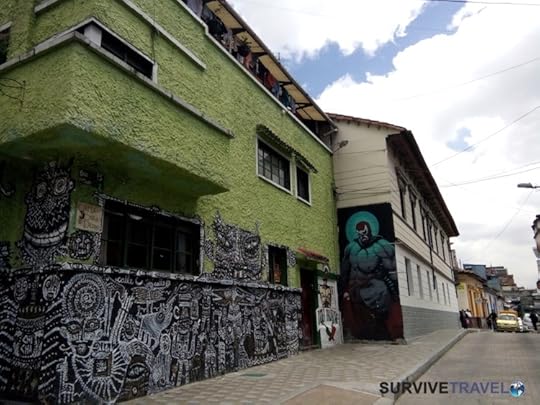
2. Museo Del Oro
The gold museum has three or four floors full of information in Spanish and English about the history of gold in Colombia. I don’t have any special interest in gold or museums but I still enjoyed this, and it was only 4,000COP to enter.

3. Museo Botero
Museo Botero is a museum featuring the work of the famous Colombian artist Botero. There are also some rooms with works from other artists, and semi-attached is the money museum which showcases the history of money in Colombia.
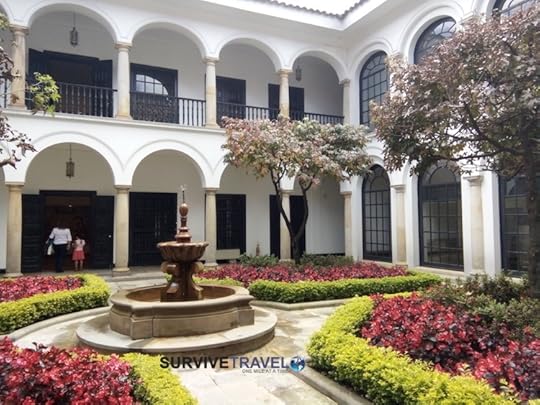
The courtyard in Museo Botero.
4. Plaza De Bolivar
At the end of my walk through La Candelaria I went to La Plaza de Bolivar. It is a good place to people watch and you can get free wifi there. There is also some nice archetecture around the general vicinity, including the Cathedral Primida.

5. Catedral de Sal
Not too far from Bogota is the quaint town of Zipaquira and in this town there is a massive cathedral carved out of a salt mine. This is a good day trip.

Overlooking Zipaquira.
6. Botanical Garden of Bogota
Set amongst the hustle and bustle of Bogota this botanical garden (jardin botanical) is a really nice place to stop and smell the flowers, literally.

7. National Museum of Bogota
A big museum in the middle of Bogota containing art, history, and more. Informational signs are mostly in Spanish, but is still worth a look even if you can’t read them. This museum was much better than I had anticipated.
Only 4,000 COP to get in. There is also free entry from 4pm to 6pm on Wednesdays and Sundays.
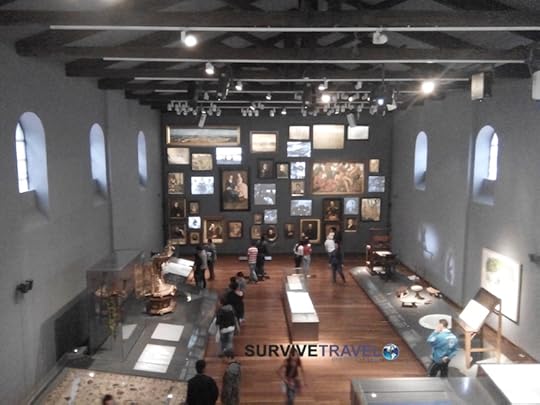
8. Avenida Septimo on a Friday Night
Check out some street performances. Live bands, dancing, artists, stuff for sale, lots of street food, and just whatever.
It probably happens on a Saturday night too.

9. Chapinero
Go for a walk around the neighborhood of Chapinero. A nice change from the ultra busy city centre.

A park in Chapinero.
10. Emerald Museum
A private museum showcasing emeralds. Not huge but you get a free guide in English or Spanish.
It took me a while to find it because there’s no sign and it’s inside an office building (Edificio Avianca). You have to go in, tell the guards you want the Museo de Esmeralda, and then someone will come to take you up to the right floor.
5,000 COP to enter. You’re not allowed to take photo’s of any of the emeralds, but you get this amazing view of the city which is almost worth the 5,000COP on it’s own.

View of Bogota from the emerald museum.
11. Plaza San Victorino
This picture does not do the vibe of this place any justice. Check out the surrounding area and in the market type buildings.

12. Plaza Paloquemao
A couple of km NW of La Candelaria is this fresh food market. Lots of fruit and vegetables, meat, and seafood.

I took this shot while walking to Plaza Paloquemao from my hotel. I wouldn’t suggest walking in this area at night.

13. Cerro de Monserrate
This is something I didn’t actually do but it is pretty famous in Bogota. Walk or take a cable car up the hill for what I imagine is an epic view but very crowed.

14. Usaquen Sunday Market
Every Sunday there is a market based around Usaquen Plaza with people selling artesan style things (jewelry, soaps, food, etc). Nice for a little walk about.

15. Ciclovia
Another Sunday only event in Bogota. From 7am to 2pm they close many of the city’s main roads off to cars so people can ride, walk, rollerblade or run around the city.
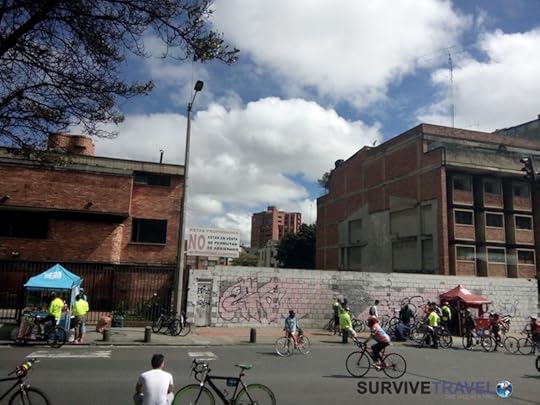
16. Parque Simon de Bolivar
The biggest park in Bogota is, well, big. I went there on a Sunday and there was some kind of music festival on so it was full of people and street vendors. I think it’s much quieter during the week.
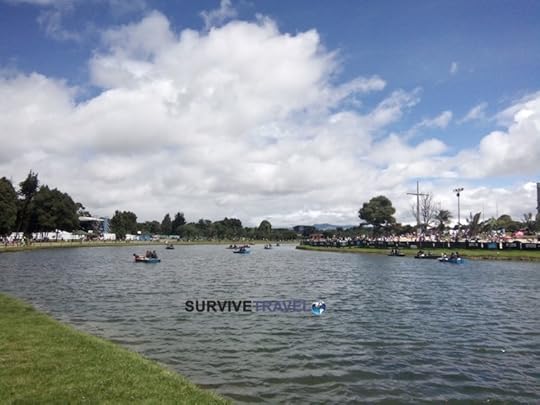
Getting to Bogota
From the airport I caught a taxi. 30,000COP. No meter, no bargaining. About 10usd and I read online it should cost no more than 15usd so I was happy with it.
There are buses you can take but unless you know Bogota and/or are really short on cash it is worth the $10 to take a cab.
Bogota being the capital of Colombia you can get a bus there from almost any city in the country, and probably from some neighboring countries also although I’m not sure how safe that would be.
Accommodation in Bogota
Whilst doing all these amazing things to do in Bogota I stayed at Hotel Los Cerros.
Cost: 40,000 COP / night
Address: Cl. 19 #15-18, Bogotá, Cundinamarca, Colombia, +57 1 3416068.
For the price Hotel Los Cerros was a pretty good place to say. Good sized room, cable TV (although there’s nothing in English), private bathroom, wifi and very clean.
The location is pretty good. Close to transport and Avenida Septima. Lots of cheap food around and easy walking distance to many points of interest including La Candeleria.
Hot water in the shower (thank god ‘cause Bogota is a bit cold in comparison with what I’m used to) but no shower head. This might be normal in Colombia though. The water just spurts out like a hose.
The wifi was good in the hallway but a bit temperamental in my room. I guess it just depends on what room you get.
Book your stay at Hotel Los Cerros or some other accommodation in Bogota.
Survive Travel.
July 2, 2017
Exploring Chapinero, Bogota, Colombia
Chapinero is a neighborhood/district of Bogota and exploring Chapinero is a nice way to get out of the city bustle while still “keeping it urban”. It wasn’t really what I was expecting, but things usually aren’t.
Exploring Chapinero
I started of by catching the transmilenio to the Nuestra Senora de Lourdes cathedral. Mass was on at the time but you can still walk around and have a look.
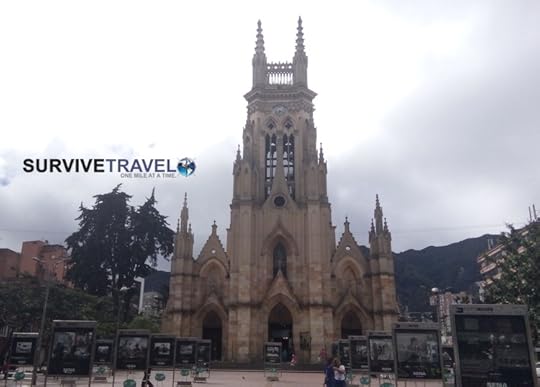
Then I weaved my way through the streets headed north. There’s lots of apartment and office buildings along the quiet streets.
Eventually I got to Virrey park where you can walk along the stream.
Virrey park was nice to walk through. There was lots of people doing stuff – yoga, cross-fit, box-ercise, walking dogs, tai chi, etc. It was a Saturday morning which probably contributed to the abundance of activity.

Continuing on I made my way to Parque de la 93. I think the attraction of this place are the surrounding restaurants at night, but otherwise it was just a small park.
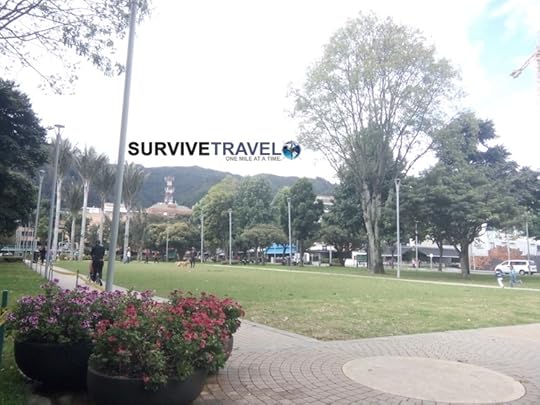
That was it. I caught a bus back to La Candelaria.
Other places of interest in Chapinero are the gay area and the big nightclub but it they were about 3 kilometers from my starting point. Also, I have no special interest in either so I decided to give them a miss.
Getting to Chapinero
I caught the transmilenio C19 towards Portal Suba and got off at Calle 63 which is only about a 2 minute walk from Nuestra Senora de Lourdes cathedral.
Have you been exploring Chapinero before? Share your thoughts in the comments 
July 1, 2017
A Walk Around the Botanical Garden of Bogota, Colombia
After going to La Catedral de Sal I decided to do a “bus to nowhere” and ended up at the Botanical Garden of Bogota.
The full name of Bogota’s botanical garden is Jardín Botánico de Bogotá José Celestino Mutis. I had actually planned to go here anyway but was just lucky to stumble upon it on the way back from Zipaquira.
Cost(s): 2,700COP per adult.
Address: Ac 63 #6895, Bogotá, Colombia. jbb.gov.co. +57 1 4377060
Botanical Garden of Bogota
The Botanical Garden of Bogota is a nice place to stroll around to get out of the hustle and bustle of Bogota, and it is a good size for spending an hour or two.
As you enter there is this nice lake with a bridge and stuff.

There are a number of different gardens including herbal, exotic, fragrance, etc. There is also useful signs. Some of them rotate and have English on the back, although I didn’t discover this until I was on my way out.
I think this is the exotic species garden.

The place was not crowded when I went (a Thursday afternoon) but there was still quite a few people with there “professional” cameras taking close-ups of flowers and portraits of their girlfriends and/or children.
Here’s one of some orchids with my phone.

The pathway circles the boundary of the gardens and you can also walk through the middle on these smaller “jungle” pathways.

Here’s another close-up of a flower. I’m not sure what it is.

The pine tree garden on a cloudy day.

Getting to the Botanical Garden of Bogota
On the way back from Zipa I decided to skip getting off at the stop I was supposed to and just see where the bus would take me. After about 30 minutes I checked my map and sawy I was under a km from the botanical garden so I got off and walked there.
To get back to town I caught the #128, but I think any bus going towards “centro” will get you back within walking distance to La Candelaria. The buses do not accept cash, only the cards which you can get from a Transmileno station. I had one but it had no money on it. Luckily some guy tapped me in and I just gave him the fare (2,000COP).
Have you been to the Botanical Garden of Bogota before? Share your thoughts in the comments 
June 30, 2017
La Catedral de Sal and Zipaquira, Colombia
On my second day in Bogota I still had a bit of jetlag so I woke up pretty early (before dawn). I decided to take advantage of the situation and use the early start to go see La Catedral de Sal and Zipaquira, which is about a 90minute journey from La Candelaria in Bogota.
La Catedral de Sal is a cathedral carved into a salt mine. It’s no small feat. The cathedral is MASSIVE. I was impressed, and Zipaquira is a pretty nice little town to explore also.
Cost(s): 50,000COP for foreigner adults.
Address: Parque De La Sal, Zipaquirá, Cundinamarca, Colombia. catedraldesal.gov.co. +57 1 8519502
LA Catedral de Sal and Zipaquira
After finally getting to Zipaquira (Zipa) I followed some directions I found on the internet to get to the Catedral de Sal and got lost, but it was kind of good because I got to see the residential side of Zipa. I planned to do this anyway (after the cathedral) but was glad I did it before instead as the cathedral was much bigger than I expected and I probably wouldn’t have bothered afterwards.
Exploring Zipaquira
After getting off the bus I crossed the road and walked straight up through the quaint streets of the town.

After a little while I got to the town square.

I must have made a wrong turn because I ended up walking through the residential area.

There is a church a bit up the hill where you can get a nice view of the town below.

La Catedral de Sal
After a bit more walking I decided to ask for directions. Eventually I got to La Catedral de Sal.
Inside there are many stopping points, each one a different part of the story of Jesus’s crucifixion. It is all carved out of the mine and they have added lights which change color for effect.

At the start I was following a tour. It was in Spanish and I am not sure if it was free but there where so many people it didn’t matter. Since I couldn’t understand most of it I broke away and managed to get this section of the place to myself long enough for a photo.

On the way out I did see/hear a guide giving the same tour in English. Maybe you just need to wait for it, or most likely it was a tour group.
There is a couple of worship areas with crosses, pews, statues, etc. Just like a church.

The size of the caverns are huge. I took this just for comparison of the cavern with the people.

Towards the end there is a light show which is a little bit psychedelic (sit at the back for the best experience) and a 3d movie which I didn’t see. They are all included with the price of your entry ticket.

There is also a small emerald “museum” and a few shops selling emeralds, food, and other souvenirs.

The last thing I checked out was this “water mirror”.
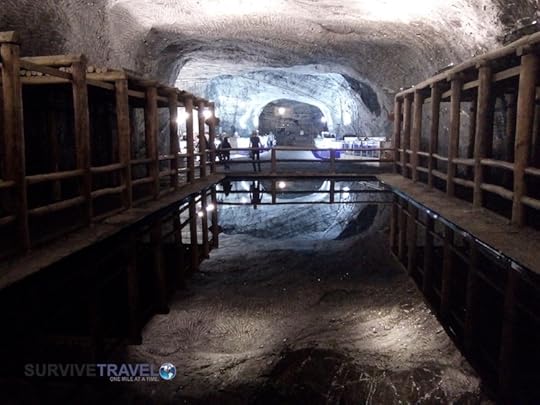
To get out you walk back the same way you came.
Getting to La Catedral de Sal In Zipaquira
I read in several places on the internet to take a Transmilenio bus to Portal del Norte from the the Agua stop in La Candelaria. This didn’t work for me, and when I looked at the map of the Transmilenio line it didn’t even connect. I ended up walking to the closest stop one the correct line. Just jump on any bus that goes to Portal De Norte. Pick one with less stop as it will be faster. I caught the B13 as suggested by the lady at the ticket counter. Apparently the B74 is the fastest.
The ticket cost me 5,200 COP. Half of that is because it was my first trip and the give you a reloadable travel card.
Once at Portal de Norte go to the Intermunicipal part of the station (look at the signs) and get on the bus to Zipaquira. They will take money from you once your moving. Just tell the guy you are going to Zipa. It cost around 5,000COP. No more than 6,000. I’m not reall sure because I gave him a 20,000 note and he just gave me back 15,000, but I am sure it’s a little more but he probably didn’t have change.
For some reason the Catedral de Sal did not show on my GPS so once in Zipa I followed some directions I got off the internet. They where wrong (or I just misread them over and over again). Make your way to the Archaeological Museum which is west on Caraterra 7. Go through the big yellow arches and follow the path to the Salt Mine.
There is also tourist train which will take you up, and it leaves from across the road of the bus stop you get dropped off at. I’m not sure of the price.
Have you been to La Catedral de Sal and Zipaquira? Share your thoughts in the comments 
June 29, 2017
A Walk Around La Candelaria, Bogota, Colombia
I arrived in Bogota around 5am and after a short rest I decided not to do too much so I just went for a walk around La Candelaria, which is the “old city” of Bogota.
I read about a self-guided route on the internet so I followed it, mostly.
A Walk Around La Candelaria
I started off with the Museo Del Oro (Gold Museum). It was pretty good. Three (maybe four) floors and lots of information in English and Spanish. Only 4,000COP to enter.

After the museum I took a walk through the historic streets. There’s lots of street art to look at.

In fact, there’s lots of street art all around Bogota.

I stopped taking photos of the art after this one.

There are some nice cobbled streets with fruit vendors and stuff.

Eventually I got to Museo Botero which is a museum featuring the art of Botero. He is a very famous Colombian artist whose focus seemed to be of fat people and fruit. It was pretty good.
I didn’t take any pictures of his art, but this is a fountain in the courtyard of the museum.

There are also some rooms with works from other artists, and semi-attached is the money museum which showcases the history of money in Colombia.
After that I headed to Plaza De Bolivar. You can see the Cathedral Primida on the way. I wanted to look inside Iglesia Santa Clara but it seemed to off limits to the pubic.
Plaza de Bolivar is a good place to people watch and you can get free wifi there.

Have you done a walk around La Candelaria in Bogota before? Share your thoughts in the comments 
June 26, 2017
12 Awesome Things to do in Seoul, Korea
This list of 12 awesome things to do in Seoul gives a short review of each of the things to do in Seoul, links to more detailed reviews (where applicable), and advise on accommodation in Seoul as well as information on getting to Seoul.
Going to Korea kind of just happened on my way to Colombia. It was cheaper to fly to Bogota from Seoul than it was from Cebu City and I got the flight from Cebu to Seoul for free thanks to an Air Asia sale and my loyalty points.
12 Awesome Things to do in Seoul
1. Ihwa Mural Village
On my first day, after getting ripped off changing money (for some reason I accepted a rate worse than what I got at the airport in the Philippines.. WTF?? ), I headed to Ihwa Mural Village.
Ihwa Mural Village is a nice little place to walk around and take pictures of street art. Street art is actually one of my favorite things to do in cities. It’s free, interesting, and just a nice casual walk.

2. Cheonggyecheon Stream
After Ihwa Mural Village I decided to keep walking to Cheonggye Plaza, which was fairly dissapointing, but it is the start (or end) of Cheonggyecheon Stream.
Cheonggyecheon Stream goes for a while, Im not sure exactly how log for but I decided to walk it until I was back at my accommodation. It was a nice walk, and there and different things to see along the sides of the stream along the way.
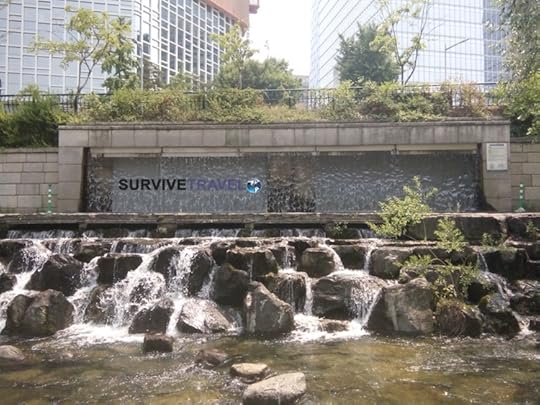
3. Gwangjang Food Street
A great place to try Korean dishes. Everything from noodle soup, raw octopus, fried foods, and I even saw a few signs for dog meat. Luckily, most of the stalls have English translations and are reasonably priced.

4. Hongdae Shopping Street
Hongdae Shopping street is pretty much what it sounds like by day. Lots of shops to go and look around in. If you are into window shopping you could easily spend a day there, but at night is when it really gets interesting. The bars and clubs open, and loads of street performers perform right next to each-other. Mainly wannabe k-pop groups (probably students earning some extra cash) and solo singers.

5. Haneul Park
Haneul Park is a nice way to spend a few hours out of the busy city of Seoul, and it is still in the city. You can take the metro right to it!
It is actually of of about 4 parks in the Olympic Park area. Nice views from the top of the hill and a big mall with a food court for afterwards.

6. Bukchon Hanok Village
After coming back from Gyeongju I met up with Ayase in Seoul and one of the first things we did was go for a walk in Bukchon Hanok Village. It was a Saturday so a little crowded with a few people in traditional costume. Tourists hire them so they can walk around the village and take pictures wearing them.
The village itself wasn’t anything special. Ihwa Mural Village was way better (IMO).
Close to the village is a fairly large park where you can climb Bugaksan mountain. We walked though it but didn’t climb as we wanted to go see the palace.

7. The National Folk Museum of Korea
In between Hanok Village and Gyeongbokgung Palace is the The National Folk Museum of Korea. It is free entry and looks fairly big, but we didn’t look around. It’s probably a good thing to do.
There’s this rather amusing sculpture/statue thing out the front. The last “kid” is Ayase.

8. Gyeongbokgung Palace
Gyeongbokgung Palace is, not surprisingly, a pretty big area. You can spend at least an hour in there, three if you have a particular interest. They have free guided tours which is probably a good thing to do to get the most out of it, or just get the audio guide. We did none of these things but it was still a pleasant walk about.

9. Namdaemun Market
A fairly big market area with lots of street food and souvenir items. Nice to walk around.

10. Fort Wall
Just south of Namdaemun market there is a park where you can walk along the wall that protected Seoul for over 500 years, the longest (time-wise) in the world. I think you could walk the whole circumference of it if you wanted, although it would be quite a long walk.

11. Starfield Library
One morning someone posted a short video on facebook about this new library in Seoul, so I decided to go check it out. Not sure if it was worth the 30 minute train ride but it was part of a massive (and very modern) mall. Ayase was happy with it.
Get off at Samseong metro station and take exit 6 into the COEX mall. Follow the signs to the starfield library.

12. Korean Bath House
I had a friend in China that used to teach English in Korea and he told me that going to a Korean Bath House was a must do, so I did, and it was great.

Getting to Seoul
From the airport there are basically three ways to get to the city. Taxi, bus, and train.
Train is the cheapest and costs under 5,000 KRW for the slow one or about 8,000 for the express.
A bus to the city cost me 15,000KRW. If you have big luggage the bus is better than the train.
I’m not sure how much a taxi costs.
If arriving by bus then you can catch the metro to you final destination. The metro system in Seoul is very good.
Accommodation in Seoul
Whilst doing all these awesome things to do in Seoul I stayed in three different places.
Dongdaemun Inn
Cost: 20,000 KRW per night.
Address: 42 Gwanghuidong 2(i)-ga, Jung-gu, Seoul, South Korea. +82 70-7443-2891
The first place I stayed at was Dongdaemun Inn. I got a private room and I think i was upgraded to a triple with private bathroom which I was pretty happy about.
The room had a small fridge, cable TV, hot shower, air-conditioner, and awesome wifi. Staff spoke good English and very helpful. Free drinking water and in an excellent location. Walking distance to many attractions and right next to metro station.
Book your stay at Dongdaemun Inn.
Getting to Dongdaemun Inn
I went there straight from the airport. I took an airport bus to Dongdaemun History and Culture Park Station and then walked west about 30m (the same direction the bus is going). The Dongdemun Inn is down the alley next to the 7-11. The journey took under an hour.
A better way is to take the express train from the airport. It is cheaper and with wifi. Take it to Seoul Station and then catch the normal metro to Dongdaemun Inn. The bus is better if you have more baggage.
Choco Residence
Cost: 18,000 KRW / night for a single room.
Address: 31-11, Wausan-ro 21-gil, Mapo-gu, Mapo-Gu, 04041 Seoul, South Korea
After two nights at Dongdaemun Inn I moved to the Choco residence. Not because I wasn’t happy with Dongdaemun Inn, it is just the way it worked out when I was booking online, i.e., I decided to stay in Seoul longer and switching hotels was the best deal at the time.
Choco residence is in a good location if you like bars and clubs, but is also good just to walk around that shopping area.
It is an actual living residence with many long-term “guests” (I’m guessing). The room is small. Tiny in fact, but it has everything you need, i.e., TV, Wifi, comfortable bed, etc, and the place is very clean. The guy that runs it is very friendly and talkative and doesn’t seem to care if you can’t speak Korean.
There’s communal kitchen, bathroom (only one for a whole floor of guests), and a clothes washing machine. Washing powder, soap, towels, toilet paper, etc. are all provided. It was very organized.
Personally, I liked Dongdaemun Inn better because of the room size and location, but Choco residence is pretty good budget accommodation in Seoul also. The main draw would be the location for those into bars and clubs.
Book your stay at Choco Residence.
Getting to Choco Residence
The closest metro stations are Hongik University or Sangsu. Choco residence is about midway between the two. I always went to Hongik.
It is just off the well known Hongdae Shopping Street. Use the map.
On the booking websites it is called Choco Residence, but it is actually called Bobo Residence.
YaKorea Hostel Dongdaemun
Cost: 36,000KRW/night for a double room. Dorms also available.
Address: Sindang 5(o)-dong, Jung-gu, Seoul, South Korea, yakoreahostel.com, +82 2-2234-1277.
The last place I stayed in Seoul was the YaKorea Hostel. It was a slightly better room than the first two places because I met up with Ayase after spending time in Gyeongju. Two people means better rooms for cheaper.
It was pretty good. Right across the road from a metro station and a good fruit juice bar across the road. Room was big enough, cable TV, hot water shower, and great security. Free water, tea, and coffee. English and Chinese speaking staff.
Book your stay at YaKorea Hostel Dongdaemun.
Getting to YaKorea Hostel
Cheeonggu station is the closest. It is not along the main road but a bit inside. Take exit three and walk across the road you are facing as you come out of the station. Turn left once across the road and then take the first right. Just follow the road a little, you should see it.
Here’s a video slideshow of all the photos from Seoul.
Got anything to add to this list of awesome things to do in Seoul? Let us know them (or anything else you want to say) in the comments 
19 Amazing Korean Foods, South Korea
Discover 19 amazing Korean foods. Before even stepping foot into Korea I knew I was going to love their food. Mostly because I love kim chi, so if I ordered anything I didn’t like then at least I could put that with it. Fortunately, but no surprisingly, I loved almost everything I tried.
19 Amazing Korean Foods
1. Bulgogi Noodles
Stir fried glass noodles with thinly sliced beef, some vegetables and a kind of sweet (but not too sweet) sauce. It was the first thing I ate in Korea and I loved it.
You can also get it with rice instead of noodles.

2. Gimbap
Pretty much sushi but with a Korean name. I got this as a cheap lunch from the 7-11. The 7-11 (and other similar stores) have quite a good range of cheap, ready to eat meals that you can nuke up in their microwave.

3. Bibimbap
Bibimbap is probably one of Koreas most famous dishes. I think it means mixed rice. It’s basically rice, meat (or can be vegetarian), and vegetables in one dish. It’s a really good all-round meal and usually pretty cheap. This particular one is Spicy Pork Bibimbap.

4. Sliced Rice Cake and Dumpling Soup
I got this from Gwangjang Food Street. The Korean name for it is Tteok-mandu-guk. A pretty nice dish. Think dumpling noodle soup but with rice cakes instead of noodles.

5. Fried Tofu Udon Noodle Soup
It seems Japanese and Korean food are VERY similiar. First sushi/gimbap and now Udon noodles.
I got this from the same place I got the bibimbap. It was a good little restaurant. Cheap, fast service (pay by automatic vendor – like a ticket machine at the metro station!) and a good range of Korean dishes.
The dish itself was as expected… delicious and filling.

6. Fast Food
I can never visit a new country without trying their version of fast food. I did it twice in South Korea. Once in a place called Mom’s (something) Chicken and Burgers on my first night in Gyeongju and another at what seems to be the South Korean version of Burger King/McDonald’s called Lotteria.
The fries at Mom’s were AMAZING! Lotteria wasn’t too bad either.

7. Korean Bao
I’m not sure of the actual name for this but it is almost identical to Chinese bao zi, only better! The outside “bread” is more like the jiao zi (dumpling) wrapper and inside is pork (I think) and vegetables.

After eating this first one I went back for a second to try the other type they had which I think was tofu and kim chi.
These are sold freshly made from a shop outside the marketplace in Gyeongju, almost directly across the road from the train station bus stop. 1,000 KRW each.
I also saw them in Namdaemun Market in Seoul. 5 for 3,000 KRW. Each was a little smaller than the ones in Gyeongju.
On our last night in Seoul we found the mini version. Pretty much the same as Xiao Leng Bao in China.

8. Korean Sweets
Inside and outside of the markets were people selling these Korean Sweets (for lack of a better name). I didn’t try them but I imagine they are similar to the Malaysian rice flour cakes, which are glutinous but delicious.

9. Korean Kebab
For lack of a better name I’m calling it a kebab. It is chicken and vegetables inside a kind of pancake mixture and rolled up. There is also a sweet one with bean paste inside it. It was tasty but quite oily. 3000 KRW from Jungang Market in Gyeongju.

10. Pork Noodle Soup
Number 10 on this list of amazing Korean foods is a dish common all over Asia – pork noodle soup. I couldn’t really say there was anything really “Korean” about this one to separate it from others I’ve had in Asia, but it was delicious none the less. Cost 6,000 KRW from Jungang Market, but can also be found in shop around the town for about the same price.

11. Gyeongju Traditional Barley Bread
As the name suggests, this is a Gyeongju specialty. Small breads made from barley wheat with mungbean paste inside so it is a little sweet. I’m a fan of mungbean so I enjoyed it. I managed to find a place that sold 3 for 2KRW, but man places you have to by them in larger amounts (6+), but they are quite small so not really an issue.

12. Ramen with Cheese
For those that don’t know, ramen is a pretty famous brand of instant noodles. It is like maggi noodles, or mi goreng. This dish is basically ramen with a slice of cheese in it. They also put a little mushroom and white cabbage and some spice for flavor. It is actually incredibly tasty.

13. Dumplings
Mandu is the Korean word for dumplings is. They are pretty much the same as Chinese dumplings (shui jiao), and are equally as delicious.

14. Banquet Noodles
This is a pretty common dish in South Korea, at least it was in Seoul. It is basically just plain silk noodles in a flavored broth. Not exactly what I was expecting with the name ‘banquet’ but I was happy with it. Simple and tasty.

15. Street Foods
There are many street vendors in Korea, mostly selling foods of the deep fried variety. Below is just a small selection of whats on offer when walking the streets of Seoul.
Gwangjang Food Street, Hongdae Shopping Street, and Namdaemun Market are some good places to check out for this in Seoul.

16. Cold Noodles
One our last full day in Seoul we went back to Namdaemun Market so Ayase could try the Korean Baozi, but instead we came across a place selling cold noodles and shaved noodles, both of which I love. We ordered one of each but they came in a set so we both ended up getting cold noodles, shaved noodle soup, and bibimbap barley – all for only 4,000KRW per set (featured picture). Must be the best deal in Seoul, it was a lot of food.

17. Hand Shaved Noodles
One of my favorite noodle dishes in China was Shao Dao Mian – shaved noodles. Just by chance we stumbled across it in Namdaemun market.

18. Tteok‑bokki (Stir fried rice cake)
This is a very common street food. It is rice cakes in a sweet and spicy sauce. Not bad and goes for about 2,500 – 3,000 KRW.

19. Stir Fried Glass Noodles
The last item on this list of amazing Korean foods is a fairly simple dish of glass noodles and vegetables mixed with a few different sauces. Nice and simple dish.

Do you know of any other Korean country foods that should be on this list? We’d love to hear about them or anything else you want to say in the comments 
Getting Pampered at Dragon Hill Spa, Seoul, South Korea
I had a friend in China that used to teach English in Korea and he told me that going to a Korean Bath House was a must do, so we did, and it was great. We chose to go to a more tourist friendly bath-house called Dragon Hill Spa. It was much better than I expected, and really great value.
Cost(s): 13,000KRW/12 hours +1,000KRW every extra hour. At night time it goes up a bit to 15,000KRW/12 hours.
Address: 40-712 Hangangno 3(sam)-ga, Yongsan-gu, Seoul, South Korea. dragonhillspa.com. +82 2-792-0001.
Getting Pampered at Dragon Hill Spa
The best bath-house I have been to was in Manzhouli where I un-intentionally stayed in a hotel that was also a bath house. I thought that was great. It’s got nothing on Dragon Hill Spa. This place has everything you need. You could live there.

Pathway to the entrance.
I didn’t take many pictures because of all the naked people that would have been in them, so you don’t really get to see all the main parts of the place.

Games area.
There are some common areas and also seperated men/women bathhouse areas.

Computer room.
In the separated areas there are showers, saunas and spas. The men’s section had a barber. I’m not sure what the women’s section had.

Barbers in the men’s section.
You get two lockers. One downstairs and another in either the mens/womens area.

Rows of lockers in the mens area.
In the common areas are also numerous saunas and a few other interesting rooms such as the ice room, pyramid room (like a meditation room), and salt room. There’s a swimming pool, a couple of places to eat, a movie area, and some sleeping rooms. Most areas have free wifi.

One of the sleeping rooms.
Things like arcade games, massages, body scrubs, food, etc. all cost extra. It gets charged to your locker bracelet and you pay on the way out. It is quite a good system.
I’m not sure how typical Dragon Hill Spa is compared to other Korean Bathhouses, but I really enjoyed it.
Getting to Dragon Hill Spa in Seoul
Dragon Hill Spa is very easy to find. Take the metro to Yongsan and take the exit that directs you to Sinyongan station. Go out and look to your right. You will see it.
Have you been to Dragon Hill Spa or another Korean Bath-house? Share your thoughts in the comments 
June 24, 2017
A Look Around Gyeongbokgung Palace, Seoul, South Korea
After coming back from Gyeongju I met up with Ayase in Seoul and on the first day, amongst other things, we went for a look around Gyeongbokgung Palace.
Cost(s): 3000 KRW per adult.
Address: 161 Sajik-ro, Sejongno, Jongno-gu, Seoul, South Korea. royalpalace.go.kr. +82 2-3700-3900.
A Look Around Gyeongbokgung Palace
We came into Gyeongbokgung Palace through one of the side entrances. The main one is a bit grander.

You cross a little bridge. I am unsure what this was for. Maybe just a kind of sewage system or something. I’m sure if we had gotten the audio tour we would have been more informed.

This must be the kings throne. I am surprised there are no cushions on it, or maybe there are and I just can’t see them.

Walking around the grounds was more appealing to me than the main courtyard. I’m not sure what all the buildings are but there are signs. I guess I just wasn’t paying much attention at the time.

This was one of my favourite spots in Gyeongbokgung Palace Grounds. Probably because of the pond.

This is the same place as above but a front view.

And yet another angle of the same place. This is from a side gate which You can’t enter.

As we were about to exit the changing of the guards ceremony started. It happens twice a day (one is definitely at 2pm) and goes for about 20 minutes. They explain what’s happening over the PA in Korean, Chinese, English, and Japanese.

Getting to Gyeongbokgung Palace in Seoul
Catch the Metro to Gyeongbokgung station and walk east. You can’t miss it. It’s huge.
We went to Anguk Station, walked north through Bukchon Hanok Village and then circled back through the park past the folk museum to the palace. A nice little circuit.
Have you had a look around Gyeongbokgung Palace in Seoul before? Share your thoughts in the comments 



